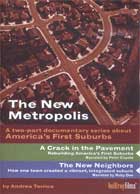
The New Metropolis 2009
Distributed by Bullfrog Films, PO Box 149, Oley, PA 19547; 800-543-FROG (3764)
Produced by Torrice Productions
Directed by Andrea Torrice
DVD, color, 53 min.
Jr. High - Adult
History, Sociology, Urban Studies
Date Entered: 11/18/2009
Reviewed by Sandy River, Architecture and Humanities Librarian, Texas Tech UniversityThe New Metropolis comprises two short documentaries on the plight of America’s first suburbs, those communities that mushroomed outside older urban areas following World War II, as the American Dream pulled people out of the inner city. Both make clear that government policies that once fueled the growth of these suburbs have now put them in jeopardy. They also raise questions about urban sprawl.
The focus of A Crack in the Pavement is the difficulty the first suburbs are having in repairing and replacing their worn infrastructure. Two communities in Ohio provide the details. Money for building the streets, sewers, and schools was available from state and federal agencies in the 1950s and 1960s, but new construction money has moved out to the communities in the next rings out from the city. The newer suburbs attract population and business away from the first suburbs because they offer modern infrastructure and lower tax rates. The loss of population and commerce means that the first suburbs have a smaller tax base to draw on, and the need to raise taxes drives more people away. These Ohio communities have taken steps to emulate the regional planning that is managing old and new suburban development in the Twin Cities area of Minnesota.
The second film, The New Neighbors, also treats the loss of population in the first suburbs, but here the focus is on the struggles of integration. Pennsauken, NJ, was almost exclusively white as early federal loan programs supported racial divisions in communities. After the passage of the 1968 Fair Housing Act, families of color started to move into the first ring of suburbs. In the mid-1990s, a woman in Pennsauken noted the For Sale signs around the home of an African American family and recognized that “white flight” was changing her community. This film documents her efforts and those of the community to maintain its population and fully integrate families of color into it. The effort starts as dining table conversations among neighbors but blossoms into seminars held at the library, leadership training to encourage diversity on the city council and in the PTA, and brochures aimed at attracting people in Philadelphia to Pennsauken. Again, the need to collaborate with neighboring communities is stressed.
These documentaries would work very well in the classroom. They are visually appealing with film footage from the 1950s and 1960s contrasting with the appearance of the communities today. While “talking head” experts do provide some broader context, the voices we hear are those of community leaders and, in the second film, citizens who care enough about their town to get involved. They sound like people we know, and we can easily understand the problems they face. The technical quality of both films is very good. Each film is short enough to allow discussion during a regular class period; faculty from various departments may find one or both to be useful supplements to class readings.